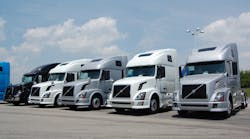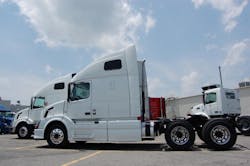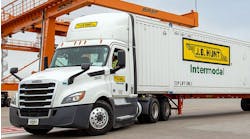New registrations of Class 4 through 8 vehicles dropped 4.2% overall from January through August this year, with registrations of Class 8 models dropping 17.1% and Class 7 vehicles down 0.6%, according to data tracked by research company IHS Markit.
Additionally, new vehicle registrations by those fleets operating more than 500 vehicles have declined, resulting in the decline of Class 8 tractors versus the same period in 2015, noted Gary Meteer, the firm’s director of commercial vehicle solutions, during a presentation at the annual Automotive Aftermarket Products Expo (AAPEX) in Las Vegas this week.
“These large fleets have been in a replacement cycle for the past five years, and large fleets have accounted for more than 50% of [Class] 8 new registrations during this period,” he said, pointing out that. Freightliner leads the market for Class 4-8 vehicles with 27% of registrations during the January to August timeframe.
“Some of this year’s slowing may be the result of uncertainty in the demand for goods with the general slowing of the economic growth in the most recent quarters,” Meteer added.
According to a “snapshot” IHS Markit took of the truck market back in June, there are 9.4 million commercial vehicles (Class 4-8) in operation on U.S. roads.When comparing new registrations against vehicles in operation, fleets operating more than 500 heavy vehicles show a 43% share of new registrations through August, while only representing 22% of vehicles in operation, he said.
By contrast, all other gross vehicle weight [GVW] classes experienced gains over the same timeframe last year, with recent analysis from IHS Markit indicating that the lowest volumes of vehicles registered to a business are to those in the Class 1, with just 24% share registered to a business, while nearly 96% of Class 7-8 commercial vehicles are registered to a business.
“Traditionally, the larger trucks have a single purpose – for work applications – versus the smaller trucks, which are used for both personal and business needs,” Meteer emphasized. “As we work our way up the weight (GVW) scale, the business use gets larger.”
While commercial vehicle new registrations are still dominated by diesel-powered engines, overall diesel share is influenced by the availability of diesel-powered engines within each GVW class.
Thus the restricted availability of diesel engines in Class 4 vehicles has pulled the overall share diesel engines account for in Class 4-8 vehicles down. When looking at engine OEMs, IHS Markit said Cummins leads the industry in share of new diesel registrations, with 38.4% of the market.
Other details the firm shared from its commercial vehicle analysis include:
- The Central and South regions of the U.S., based on IHS Markit definitions, account for 30% and 28% of the vehicles in operation respectively.
- Nationally, the largest vehicle population is heavy tractors at 34% of the vehicle population followed by straight trucks. Overall, Class 8 trucks account for 45% of the vehicle population nationally.
- The “sweet spot” for full commercial vehicle overhaul is about five to six years and as a result IHS Markit data indicates that there are less than 200,000 Class 4-8 2010 model year vehicles in operation and less than about 100,000 units, on average, of 2008-2011 model year Class 8 units in the vehicle population.
- Nationally, the average age of commercial vehicles (Class 4-8) on the road is 14 years, which is the highest it has been since IHS Markit began tracking this metric.
- Some of the oldest vehicles on the road are Class 6 straight trucks and all buses.
- In Canada during the first eight months of 2016, new commercial vehicle registrations (Class 4-8) were down 8.2% from the same timeframe last year, with the largest declines in Class 8 trucks, down more than 21%.
- Commercial vehicle growth segments in Canada include Class 3 at 1.7%; Class 4 at 12.5%, and Class 7 with nearly 6% growth through August.




